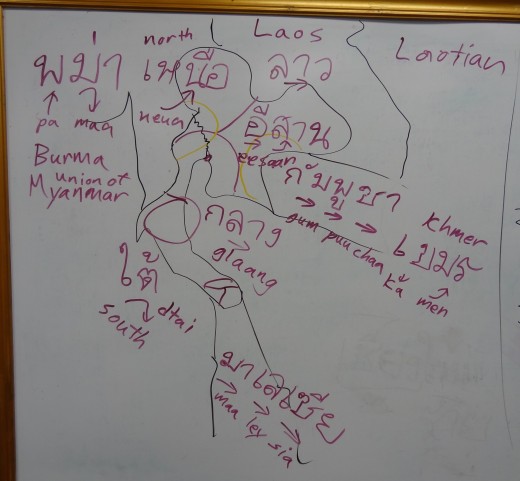4) Method #4: Use arrows/lines to represent tones.
This method involves the use of lines and/or arrows above each syllable to represent the tone. This is by far the most intuitive method of all of them, requiring little explanation for a beginner.
The method is as such:
 |
High tone
|
|
Mid tone
|
|
Low tone
|
|
Rising tone
|
|
Falling tone
|
The below image is from a recent class I taught my Thai language students on Thai geography. As you can see, the arrow method works quite well and is my preferred method. It’s also very easy to see and hard to confuse if my handwriting is sloppy.

The biggest issue with this method however is typing it. Windows does have ↑→↓ arrow characters, but it doesn’t have one for rising and falling. I also cannot put them above a syllable. Although, I have seen learn Thai books that have somehow managed to use this method in print, I don’t know how to do this in Microsoft Word . . .
Method #5: Number the tones.
This method uses a number after each syllable to represent the tone of that syllable. I first saw this method when a Chinese friend of mine was using it on facebook to write Chinese words in the English alphabet. I immediately liked it because it is nearly effortless to type a number (as opposed to the other methods).
The method works as such:
1 – mid tone
2 – low tone
3 – falling tone
4 – high tone
5 – rising tone
Example: sa2wat2dee2 krap4
(notice a space was added before krap4 to signal a new word, as opposed to a new syllable)
Unfortunately this method is the least intuitive method and hardest to learn. Heck, the tones aren’t even ‘in order’! What is the logic behind it, anyway?
This is the system taught to every Thai child, with tones in that exact order. Thais do not know the difference between ‘high’, ‘low’, ‘falling’, etc. If you ask them what tone a word uses they will repeatedly mumble the word in that order, with a different tone each time, counting on their fingers until they find a match. They will then say ‘it is the 3rd tone’ (or whatever), clearly having three fingers up (although, sometimes they can’t make up their minds). So, you need to memorize this system anyway to understand their answer.
But I will admit, I’m lazy, and typing in a single number is much less time consuming when writing up large vocabulary lists than using the other methods . . .






Comments:
Andy:
Don’t know why you haven’t found them in Word, but there are arrows defined in the Unicode standard for rising and falling – ↗ and ↘. There is also an arrow ↷ and its counterpart ⤻, which are even closer to the sound in Thai. However not every font will contain them.
Mike:
@Andy
What font makes those nice rounded rising and falling arrows you put in your last post? I’m having trouble locating them.